Harrold Bridge
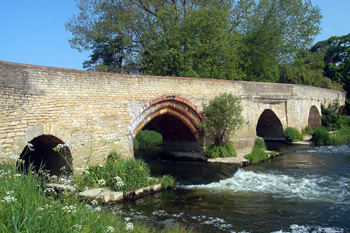
Harrold Bridge in May 2008
Harrold Bridge is well covered (seven pages) in Bridges of Bedfordshire by Angela Simco and Peter McKeague, jointly published by Bedfordshire County Council and Bedfordshire Archaeological Council and the Royal Commission on the Historical Monuments of England as Bedfordshire Archaeology Occasional Monograph Series Number 2 in 1997. This publication details archaeological evidence for the history of the bridge, whilst this article concentrates on documentary sources.
Harrold Bridge was listed by the former Department of Environment in 1964 as Grade II* (of special interest and particular importance). It is built of coursed limestone rubble and is held to date from the 14th century, though with many later repairs. Indeed, as will be seen below, the history of the bridge is one of repairs. Six arches, covering 213 feet, span the River Great Ouse and are known as The Great River Bridge. There is a 49 foot causeway for traffic on the south side then nine flood arches cross the fields for another 197 feet. South of the road bridge a foot causeway crosses another 650 feet of field, which regularly floods, parallel to the modern road to Carlton. The bridge is quite narrow and, today, traffic only flows over it one way at a time, governed by a set of traffic lights. The parish boundary with Carlton lies directly south of the bridge.
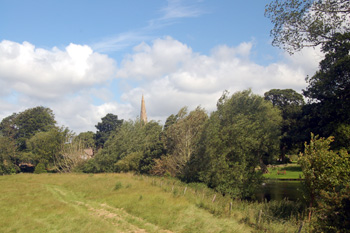
Site of Harrold Priory seen from the Bridge - June 2008
The Middle Ages
The first mention of the bridge in history is in the period 1136 to 1146 noted in an article on a dispute involving Harrold Priory in Bedfordshire Historical Records Society Volume 32, published in 1952, a translation being: "three acres of my lord's meadow next to the place of Harewold bridge" [tres acras prati de dominio meo in propinquiori loco ponti de Harewold].
The next reference is in the coroner's rolls for 1274, translated in Volume XLI of the Bedfordshire Historical Records Society publications by R.F.Hunnisett (the originals are held by The National Archives at Kew) when Robert le Herdman of Riseley collapsed and died on a path "which extends to Harrold bridge". Four years later it was referred to in the Hundred Rolls in a section dealing with the boundaries of fisheries held at Harrold and Odell [translation in Bedfordshire Historical Records Society Volume 69].
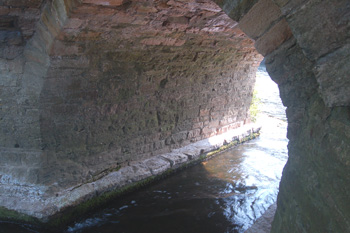
Small arch at Harrold Bridge May 2008
The Sixteenth Century
A number of early sixteenth century wills make bequests for the upkeep of the bridge was follows:
- Thomas Russell of Stevington in 1509 - leaving two bushels of barley [ABP/R1509 f.203];
- Richard Rabett of Podington in 1511 - leaving a half a quarter of barley [BHRS volume 45 - Wills 1480-1519 - published 1966];
- Thomas Amowr of Carlton in 1516 - leaving twelve pence [BHRS volume 37 Wills and Recipes - published 1958];
- John Russell of Stevington in 1529 - leaving two bushels of barley [ABP/R3 f.28];
- John Cheny of Harrold in 1555 - forty shillings [ABP/R13/63]
- Robert Blote of Harrold in 1556 - three shillings and four pence [ABP/R13/81]
The first mention of repairs is in a bailiff's account of 1532-1533 [L26/573] in which arch number two, the responsibility of the Earls of Kent, was repaired; it reads as follows:
"Payd for reparacyons done apon the kynges bryge at Harrold:
- Item to our carpenter for fallyng of tymber and hewing the same for the sayd bryge 12d;
- Item to the sawyers for sawing the same tymber the wyche was 200 fote and a half at 13d every 100 2s 8½ d;
- Item for careying the same tymber to the sawe pitt 6d;
- Item to the carpenter and his man for leying the planks apon the bryge and mending the same for two dayes and a half at every day 11d 2s 3½d
- sum 6s 6d.".

QSX19 - plan copied from a supposed 17th century description of repair responsibility for the bridge
The Seventeenth Century
Repairs now dominate the references: in 1844 a case was prepared for counsel on the liability of repair the bridge which quoted an "ancient manuscript now in the possession of John Higgins" from about 1630 which ran as follows: Harrold Bridge 4 High Arches, ye first Sir Ricd Chetwode ye 2nd ye Earl of Kent - ye 3rd and 4th ye Lord Mordaunt. The one and thirty Arches on the Long Bridge and County repairs" [QSX19].
In 1651 a presentment was made at Quarter Sessions that the bridge was out of repair [TW841]; this is the first surviving document to mention the responsibility of the county for repair of part of the bridge. In 1667 the Dowager Countess of Peterborough (clearly successor to Lord Mordaunt) was ordered to repair the third and fourth arches by the Assizes [HSA1667S12]. The following year Sir Thomas Alston was replaced as treasurer "for the monies to Harrold Bridge" by Sir William Beecher and Robert Compton [TW848].
In 1694 it was again presented at the Assize that the bridge was out of repair [X122/2] and that the Earl of Peterborough (as Lord of the Manors of Stagsden, Turvey and Chellington), Edward Reynolds (Lord of the Manor of Carlton) and Charles Cutts (Lord of the Manor of Carlton Stayesmore) were partially responsible for repair.
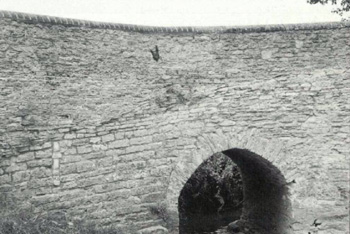
East face of Arch 10 before repair showing line of causeway approach
The Eighteenth Century and Later
In 1757 Joseph Cole, Steward to the Earl of Hardwicke, wrote about the arch of which repair was assigned to the Earl of Kent around 1630, whose successor in title Earl Hardwicke was. This arch was shown in a sketch of about 1825 with a flat top [GA2] that the Earl: "talked of, and wished to be of stone, as the two belonging to two other Proprietors are", Cole, however, considered that the then current arrangement of wooden beams could be made to last another fifty years [L24/242]. In the same year the smaller arches maintained by the county were to be repaired [QBM1].
A letter of 14th February 1795 reported that melting ice and snow had resulted in a flood which had rendered Harrold Bridge impassable and had swept that at Emberton [Buckinghamshire] away. The bridge at Harrold was damaged by a flood in 1824 [QBM1] and the county maintained part was repaired the next year, after an indictment at Quarter Sessions noted that it was unsafe [QBM1]. An earthen ramp gave access to the river section of the bridge and in 1828 a retaining wall was built, forming the passing bay of which still survives [QBM1]
In 1825 it was reported that: "Harrold Bridge was and yet is in a ruinous, broken and dangerous" condition" [GA2/1]. It was reported at Quarter Sessions in 1835 that the second arch was "much out of repair" [QBM1], four years later Earl de Grey refused to pay for repairs [QBM1] and three years after this, in 1844, the case for counsel was prepared as to who should be responsible for repairs [QBM1 and L24/244-245].
The case was as follows: "This Bridge is an ancient structure over the River Ouze at Harrold…the Bridge consists of 4 principal arches at the North end over the main stream with several Land arches at the South end for carriage way which appear to be of more recent date - and a long causeway with many arches as a foot and horse way". The document of about 1630 [see above] was then quoted: "The Arch No.1 (beginning at the North end of the Bridge) is repaired by Mr.Alston who is possessed of the Manors of Odell and a large Estate in those parishes formerly the property of Sir Richard Chetwode …No.2, until the present question arose, was immemorially repaired by the Earl de Grey and his ancestors the Earls of Kent, whose possession of the Manor of Harrold and the greater part of that parish…can be traced as far back as the year 1234. This portion of the Bridge is not arched but the Carriageway is formed by Timbers resting from pier to pier, which Timbers were entirely renewed by Earl de Grey about 8 years ago to prevent accidents but on express condition that it was not to prejudice the question of his liability to repair. The difference in style in this part of the Bridge raises a strong inference that it was not constructed or repaired by the parties which have built and repaired any of the other parts of the Bridge. Nos 3 & 4 are repaired by the Misses Trevor who are possessed of the Manor of Chellington…and of lands in Carlton, to all of which they derive Title from the Mordaunt family. The remainder of the Bridge Southward is repaired by the County" [QBM1]. Counsel's opinion was that Earl de Grey was responsible for repair.
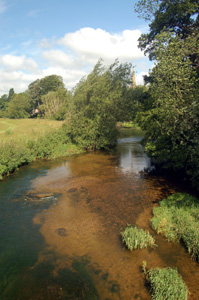
River Great Ouse looking upstream from Harrold Bridge - June 2008
Two cuttings from the Bedfordshire Times show how dangerous crossing Harrold bridge could be. The first, from 24th January 1846 reads: "SINGULAR ACCIDENT AND DISGRACEFUL CONDUCT OF ONE OF THE PARTIES. On the evening of Thursday week as a man in the employ of Mr.Biggs, miller, of Harrold, was approaching Harrold Bridge from Carlton with his horse and cart, he met a person in a gig just at the end of the bridge. On backing his cart, which was laden with grain, to allow the gig to pass him, the pales by the sides of the bridge gave way, and the cart and horse were precipitated from a height of seven or eight feet into the adjacent meadow. Providentially the man escaped unhurt, and the horse was but slightly injured by the fall; the shafts of the cart, however, were broken. Unlike the good Samaritan, whose exemplary conduct is recorded as a pattern to humanity, the person in the gig drove off without making the slightest inquiry relative to the result of the accident, or offering any assistance to his fellow man. The bridge, no doubt, will undergo an inspection by the county surveyor".
The issue of 30th January 1847 recorded: "An accident likely to be attended with the most serious consequences, happened last Friday week, at this bridge. The Rev.Mr.Garde, in company with his wife, was leaving Harrold in a fly, which was driven by his coachman, on a visit to the Rev.Mr.Russell of Turvey. When passing over the bridge, the horse shied and became unmanageable. The animal leaped the woodwork of this inconvenient bridge, and seemed disposed to pull the fly, the coachman, as well as the Rev.gentleman and his lady, into the water. The horse in a strangling position, having crossed the wooden barrier, struggled violently until some labourers who happened to be coming that way at the time, cut the traces by which means the animal was precipitated into the water below, leaving the carriage on the bridge. Mr.Garde, his lady, and the coachman, sustained no personal injury. We need scarcely add, however, that they were exceedingly alarmed at their perilous condition. The horse, which is valued at from £30 to £40 was killed by the fall".

Proposed new bridge of 1847 [QSX19]
In 1847 there was a plan to build an iron bridge, as shown above [QSX19]. Thankfully this was not carried out and the medieval bridge remained. That same year a plan was devised to build a bridge on a completely different site - the proprietors to be exonerated from future repairs in return to their contributions to build it. The land was to be given by Alston of Odell and the Misses Trevor were to: "put down at their own expense a proper fence where the causeway now stands". This plan went as far as a specification being drawn up and a tender for £2,950 being accepted, but the Misses Trevor refused to co-operate, so in the end it all came to nothing.
Two years after this the Misses Trevor declared that they were not responsible for repairing the fourth arch of the bridge because it had previously been repaired at county expense. This contention was sustained after a case at assizes in 1855, the result of which was that the first arch would be maintained by Alston, the second by earl de Grey and the third by the Misses Trevor, the rest being the responsibility of the county.
In 1856 Earl de Grey finally relented and repaired his arch. He repaired it to a greater width than the others and the surviving brick coping shows the extent of the work. This led to Quarter Sessions ordering that the county part of the bridge be augmented by a parapet to be in conformity with the new work; at least thirty yards of raised causeway were so altered and the bridge was also widened on the western side [QBM1]. In 1859 Alston was recommended to broaden arch number one to conform with the rest [QBM1] - the work survives.
In 1878 a traction engine severely damaged the first flood arch necessitating repair [QBP2]. Three of the flood arches were widened following structural failure in 1893 [Hi/C/M2].
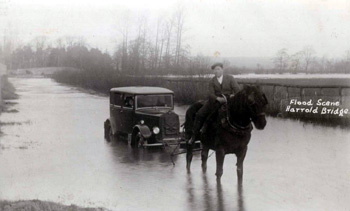
Flood at Harrold Bridge 5th January 1915 [Z1306/54]
It was not until 1st November 1930 that the Highways & Bridge Committee of Bedfordshire County Council resolved that they would take over maintenance of the whole bridge. The task continues, Harrold Parish Council records showing further major repairs between 1986 and 1992 [PCHarrold14/16]. Harrold Bridge was, again, being repaired at the time of writing [2008]
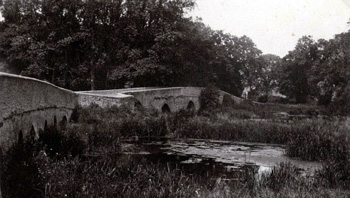
Harrold Bridge about 1920 [Z1130/54/47]